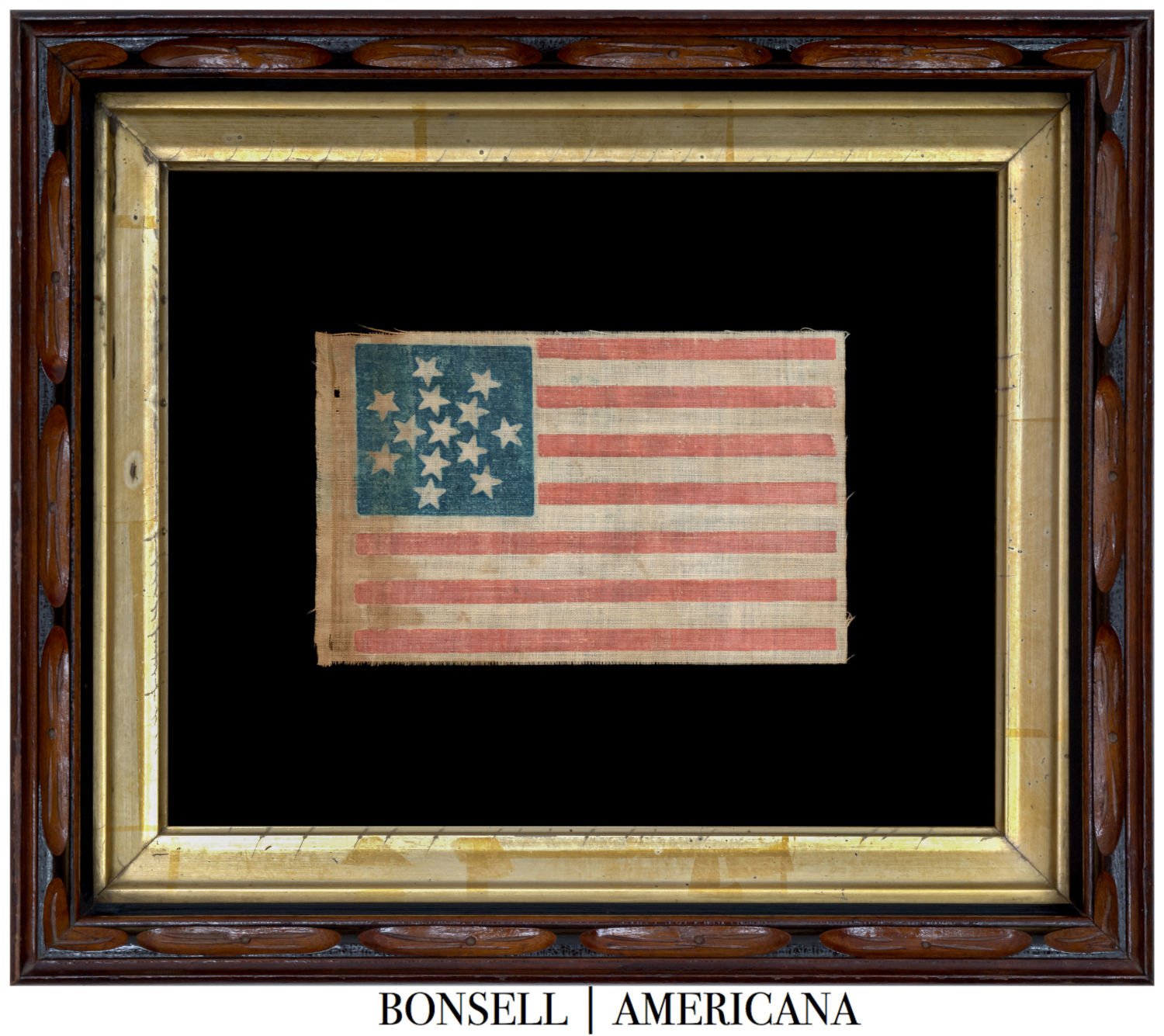7 Star Antique Flag with a Handwritten Note from Mary Babbitt to Leila Babbitt | Founders of the Babbitt School | Circa 1891
7 Star Antique Flag with a Handwritten Note from Mary Babbitt to Leila Babbitt | Founders of the Babbitt School | Circa 1891
Frame Size (H x L): 11.5” x 13.5”
Flag Size (H x L): 3.5” x 6”
Offered is an exceptional parade flag with the following, handwritten overprint:
From Miss Mary,
Go Leila, Remembrance
of the School
Mendham. June 18th 1891.
Select School
of Miss Mary & Miss Leila
Babbitt
Mary and Leila Babbitt founded the Babbitt Select School in 1884, in Mendham, New Jersey. Mendham is nestled in the hills of Morris County. Unfortunately, beyond this, little seems to be known about the Babbitt’s or the school. But even so, this is a special flag, in that we know where it began its life and how it was used.
Seven-star flags surface in a smaller size and a larger size. The smaller sized flags are approximately two inches by three-and-a-half inches. In contrast, the larger sized flags are approximately three-and-a-half inches by five-and-a-half inches, and they are much rarer than the smaller sized flags. The flag offered herein is one of the larger sized flags.
Thirteen-star parade flags were commonly waved at centennial celebrations in 1876, which were held across the country and, most notably, in Philadelphia at the Centennial International Exhibition. The seven-star flag offered herein is similar, but instead made with southern sympathies to commemorate the first wave of states that seceded from the Union, beginning in 1861. The first wave included Louisiana, Georgia, Alabama, Florida, Mississippi, South Carolina, and Texas. A second wave included Arkansas, Tennessee, North Carolina, and Virginia, and it completed the final grouping of the Confederate States of America. Not only did Southerners (and Southern Sympathizers) wave seven-star parade flags, they also occasionally waved eight-star and nine-star versions, though with much less frequency. They, too, celebrated the initial wave of states seceding from the union.
New Jersey, though geographically situated in the North and typically aligned with the Union during the American Civil War, harbored a complex array of political and social sentiments during the era. While the state's industry and economy largely benefited from its ties to the North, many of its residents, particularly those in the agricultural southern regions, felt a cultural and economic affinity with the South. These sympathies were rooted in New Jersey's historical connections to the South, its agrarian interests, and the state's contentious stance on issues such as slavery and states' rights. The state even had a "Peace Democrat" or "Copperhead" faction, which opposed the Civil War and advocated for a negotiated peace with the Confederacy. While New Jersey did not secede and its troops fought valiantly for the Union, it's evident that the state's loyalties during this tumultuous period were more nuanced than a simple North-South dichotomy might suggest. Such complexities might explain why the flag offered herein traces to New Jersey, despite such flags (i.e., seven star flags) typically tracing back to the South.
Conservation Process: This flag was hand sewn to cotton fabric, and both were hand sewn to a mounting board. To prevent the black dye in the cotton fabric from seeping into the flag, it was first washed in a standard wash and then in a dye setting wash. The flag is positioned behind Optium Museum Acrylic.
Frame: This flag is in a multitiered frame with an outer walnut layer and an inner gilded layer. It dates to between 1860 and 1890.
Condition Report: There are stains across the surface. The red and blue portions have faded slightly. There is some damage to the vertical white strip. Overall, it is attractive and age appropriate.
Collectability Level: The Great – Perfect for Rising Collectors
Date of Origin: 1888
Number of Stars: 7
Associated State: The Confederate States










